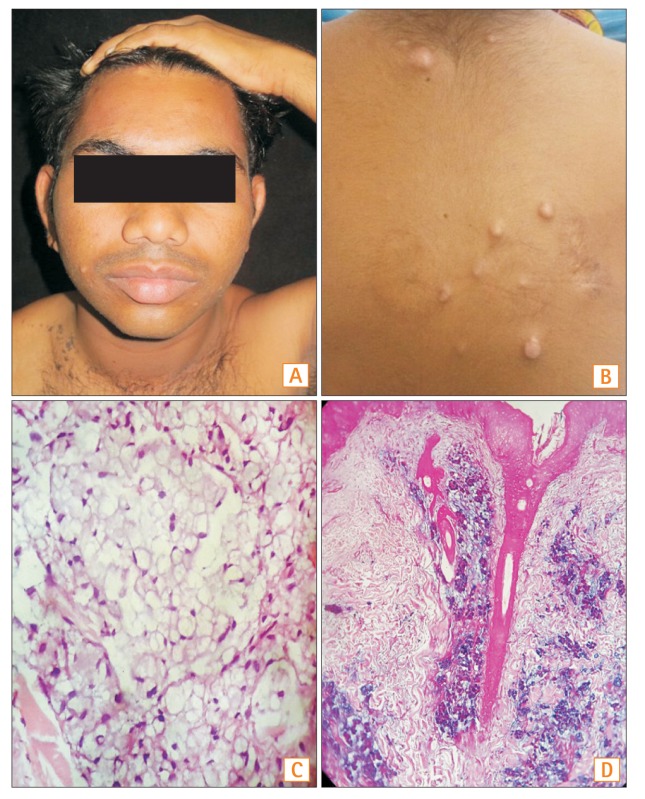

Question: A 23-year-old man had multiple nodular painless lesions all over his body since 2 months. He had undergone emergency colostomy 1 year previously for intestinal obstruction due to an ulceroinfiltrative mass in the descending colon. Histopathology showed a mucinous adenocarcinoma (signet-ring type). The patient underwent left hemi-colectomy and received 6 sessions of 5-fluorouracil- and oxaliplatin-based adjuvant chemotherapy for the tumor (T3N2M0).
On physical examination, the patient was pale and had firm-to-hard non-tender nodules of varying sizes over the scalp, face, abdomen, back, and arms (Fig. A, B); the maximum nodule size was 8×8 mm. On microscopic examination, the nodules showed a basket-weave pattern of the stratum corneum, with follicular plugging and increased basal layer melanization. The dermis was infiltrated, showing a narrow green zone and foamy cells with a mucin-like substance (Fig. C, D; alcian blue staining, C: ×40, D: ×10). Imaging did not show any metastatic lesions in the liver or lungs.
What is the diagnosis for this lesion?
The above findings confirmed a metastatic focus of the mucinous colon adenocarcinoma. Cutaneous metastases in colorectal carcinoma are rare, occurring in 2.3%–6.0% of cases.1 The most frequent site of cutaneous metastases of colon cancer is the abdomen with an operative scar, with the scalp, face, arms, and genitalia being uncommon sites.1 On macroscopic observation, lesions appear as painless, firm nodules or purple-red indurations termed as carcinoma erysipeloides, or they may be mistaken as lipomas or neurofibromas.2 The microscopic features of metastatic lesions resemble those of the primary tumor. Skin metastases are a poor prognostic indicator of colon cancer, and patients survive for an average of 18 months.3 No clear guidelines exist regarding the optimum chemotherapeutic regimens. The patient reported herein died of disseminated malignancy and anemia within 1 week of hospital admission.
References
1. Nesseris I, Tsamakis C, Gregoriou S, Ditsos I, Christofidou E, Rigopoulos D. Cutaneous metastasis of colon adenocarcinoma: case report and review of the literature. An Bras Dermatol. 2013; 88(6 Suppl 1):56–58. PMID: 24346880.

2. Kauffman CL, Sina B. Metastatic inflammatory carcinoma of the rectum: tumor spread by three routes. Am J Dermatopathol. 1997; 19:528–532. PMID: 9335247.
3. Krathen RA, Orengo IF, Rosen T. Cutaneous metastasis: a metaanalysis of data. South Med J. 2003; 96:164–167. PMID: 12630642.





 PDF
PDF ePub
ePub Citation
Citation Print
Print


 XML Download
XML Download